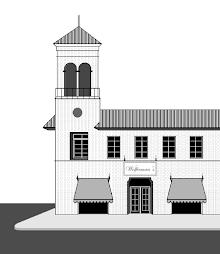Alexander Turney Stewart's Marble Dry Goods Palace initiated a retail revolution in mid-19th century Manhattan. A second Stewart store, the Iron Palace, opened, at Broadway and 10th Streets, in 1862.
This store was located in an area that became known as the "Ladies' Mile." It extended along Broadway and Sixth Avenue, between 9th and 23rd Streets, and comprised the commercial epicenter of the city. Stores had been built here by Lord & Taylor (1870), B. Altman (1877) and R.H. Macy & Company (1879).
Rowland Hussey Macy's first commercial emporium in New York had opened October 28, 1858. It would eventually surpass all other Big Apple-based retailers and, by the 21st century, stand as the only remaining, coast-to-coast -forty-five state- department store chain.
However, as Mr. Macy was building his empire, other department stores had opened across the frontier. This began to fulfill a merchandising manifest destiny. The more important of these players were...
*Gimbel Brothers (1887), Milwaukee [divisions formed in Philadelphia, New York City and Pittsburgh]
*John Wanamaker & Company (1876), Philadelphia
*Kaufmann's (1871) [Founded by Jacob and Isaac Kaufmann], Pittsburgh
*William Filene & Sons (1881), Boston
*Marshall Field & Company (1881), Chicago
*Dayton Company (1902) [Founded by George Draper Dayton], Minneapolis
*F & R Lazarus (1851) [Founded by Simon Lazarus], Columbus (OH)
*W M Burdine & Son (1896), Miami (1898)
*Woodward & Lothrop (1887) [Founded by Samuel Walter Woodward and Alvison Mason Lothrop], Washington, DC
*Foley's (1900) [Founded by Pat and James Foley], Houston
*Morris Rich Dry Goods (1867), Atlanta
*Belk Department Stores (1888) [Founded by William Henry Belk], Charlotte
*The Bon Marche (1890) [Founded by Edward Nordhoff], Seattle
*The Emporium (1896) [Founded by Adolph Feiss], San Francisco
*The Broadway (1896) [Founded by Arthur Letts], Los Angeles
*Denver Dry Goods Company (1894) [The Denver], Denver



